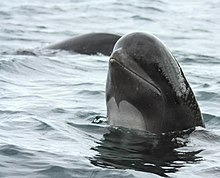Globicephala melas
| Long-finned pilot whale | |
|---|---|
 |
|
 |
|
| Size compared to an average human | |
| Scientific classification | |
| Kingdom: | Animalia |
| Phylum: | Chordata |
| Class: | Mammalia |
| Order: | Artiodactyla |
| Infraorder: | Cetacea |
| Family: | Delphinidae |
| Genus: | Globicephala |
| Species: | G. melas |
| Binomial name | |
|
Globicephala melas Traill, 1809 |
|
| Subspecies | |
|
Globicephala melas melas |
|
 |
|
| Range map | |
| Synonyms | |
|
Globicephala melaena |
|
Globicephala melas melas
Globicephala melas edwardii
Globicephala melaena
The long-finned pilot whale (Globicephala melas) is a large species of oceanic dolphin. It shares the genus Globicephala with the short-finned pilot whale (Globicephala macrorhynchus). Long-finned pilot whales are known as such because of their unusually long pectoral fins.
Pilot whales get their name from the original belief that there was a "pilot" or lead individual in their groups. The name for the genus, Globicephala, is derived from a combination of the Latin words globus ("globe") and kephale ("head"). The specific name melas is Greek for "black". This species has also earned the nickname of pothead whale in some places because the shape of its head reminded early whalers of black cooking pots. Long-finned pilot whales are commonly referred to as blackfish, which is a named shared with several other large dolphin species including short-finned pilot whales, killer whales, false killer whales, pygmy killer whales, and melon-headed whales.
This species was first classified in 1809 by Thomas Stewart Traill and given the name Delphinus melas. However, this scientific name was changed later to Globicephala melaena. Then in 1986, the specific name for this species was reverted to its original form melas.
The sexes are dimorphic, with females reaching lengths of up to 5.7 meters and 1,300 kg, while males are significantly larger at up to 6.7 meters and 2,300 kg.
Despite its common name, the long-finned pilot whale is actually a large species of dolphin. The same is true of orcas and several other small whales. It has a bulbous forehead and is black or dark grey in colour with light grey or white markings on the throat and belly regions. This light grey patch found on the throat of pilot whales forms the shape of an anchor. Some individuals have other distinct markings such as a light coloured area behind dorsal fin, known as a saddle patch, as well as an upwards sweeping stripe just behind the eye. The dorsal fin is thick and falcate in nature, and is located about a third of the way down the length of the animal. The common name of this species is a reference to the pilot whale's long, sickle-shaped pectoral fins that are 18 to 27 percent of its total body length. Being a toothed whale, pilot whales have a single blow hole.
...
Wikipedia

